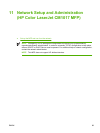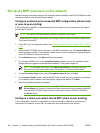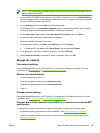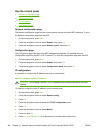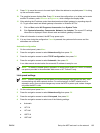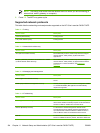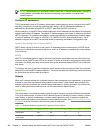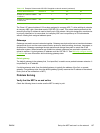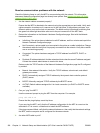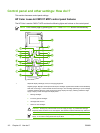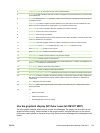
NOTE When assigning IP addresses, always consult the IP address administrator. Setting the
wrong address can disable other equipment operating on the network or interfere with
communications.
Configure IP parameters
TCP/IP parameters (such as IP address, subnet mask, default gateway) can be configured on the MFP
manually (for example, through the embedded Web server, and HP management software), or
automatically downloaded using DHCP or BOOTP each time the MFP is turned on.
When powered on, a new MFP that is unable to retrieve a valid IP address from the network automatically
assigns itself a default IP address. The default IP address depends on the type of network to which the
MFP is connected. On a small private network, a technique called link-local addressing is used to assign
a unique IP address in the range of 169.254.1.0 to 169.254.254.255, which should be valid. The IP
address configured on the MFP can be determined by inspecting the Network Configuration page.
Dynamic Host Configuration Protocol (DHCP)
DHCP allows a group of devices to use a set of IP addresses that are maintained by a DHCP server.
The device or host sends a request to the server, and if an IP address is available, the server assigns
it to that device.
BOOTP
BOOTP is a bootstrap protocol used to download configuration parameters and host information from
a network server. BOOTP uses UDP for its transport. In order for devices to boot and load configuration
information into RAM, they must communicate through the bootstrap protocol BOOTP as a client with
their server.
To configure the device, the client broadcasts a boot request packet containing at least the hardware
address of the device (MFP hardware address). The server answers with a boot reply packet containing
the information the device needs to configure.
Subnets
When an IP network address for a particular network class is assigned to an organization, no provision
is made for more than one network being present at that location. Local network administrators use
subnets to partition a network into several different subnetworks. Splitting a network into subnets can
result in better performance and improved use of limited network address space.
Subnet mask
The subnet mask is a mechanism used to divide a single IP network into several different subnetworks.
For a given network class, a portion of an IP address that would normally be used to identify a node is
used, instead, to identify a subnetwork. A subnet mask is applied to each IP address to specify the
portion used for subnetworks, and the portion used to identify the node. See
Manually configure a static
IP address for more information about obtaining subnet mask data.
Table 11-5 Example: Subnet mask 255.255.0.0 applied to class A network
Class A Network Address Network 15 xxx xxx xxx
Subnet Mask 255 255 0 0
IP Address fields with Subnet
Mask applied
Network Subnet Host Host
106 Chapter 11 Network Setup and Administration (HP Color LaserJet CM1017 MFP) ENWW




